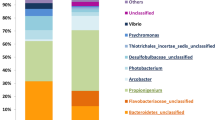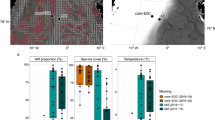Abstract
Dramatic decreases in the extent of Arctic multiyear ice (MYI) suggest this environment may disappear as early as 2100, replaced by ecologically different first-year ice. To better understand the implications of this loss on microbial biodiversity, we undertook a detailed census of the microbial community in MYI at two sites near the geographic North Pole using parallel tag sequencing of the 16S rRNA gene. Although the composition of the MYI microbial community has been characterized by previous studies, microbial community structure has not been. Although richness was lower in MYI than in underlying surface water, we found diversity to be comparable using the Simpson and Shannon's indices (for Simpson t=0.65, P=0.56; for Shannon t=0.25, P=0.84 for a Student's t-test of mean values). Cyanobacteria, comprising 6.8% of reads obtained from MYI, were observed for the first time in Arctic sea ice. In addition, several low-abundance clades not previously reported in sea ice were present, including the phylum TM7 and the classes Spartobacteria and Opitutae. Members of Coraliomargarita, a recently described genus of the class Opitutae, were present in sufficient numbers to suggest niche occupation within MYI.
Similar content being viewed by others
Log in or create a free account to read this content
Gain free access to this article, as well as selected content from this journal and more on nature.com
or
Accession codes
References
Acinas SG, Marcelino LA, Klepac-Ceraj V, Polz MF . (2004). Divergence and redundancy of 16S rRNA sequences in genomes with multiple rrn operons. J Bacteriol 186: 2629–2635.
Alonso-Sáez L, Sánchez O, Gasol JM, Balagué V, Pedrós-Alio C . (2008). Winter-to-summer changes in the composition and single-cell activity of near-surface Arctic prokaryotes. Environ Microbiol 10: 2444–2454.
Altschul SF, Madden TL, Schaffer AA, Zhang J, Zhang Z, Miller W et al. (1997). Gapped BLAST and PSI-BLAST: a new generation of protein database search programs. Nuc Acids Res 25: 2289–3402.
Bano N, Hollibaugh JT . (2002). Phylogenetic composition of bacterioplankton assemblages from the Arctic Ocean. Appl Environ Microbiol 68: 505–518.
Barber DG, Galley R, Asplin MG, De Abreu R, Warner K-A, Pu et al. (2009). Perennial pack ice in the southern Beaufort Sea was not as it appeared in the summer of 2009. Geophys Res Lett 36: L24501.
Barbeyron T, Lerat Y, Sassi J-F, Le Panse S, Helbert W, Nyvall Collen P . (2010). Persicivirga ulvanivorans sp. nov., a marine Flavobacteriaceae degrading ulvan from green algae. Int J Syst Evol Microbiol, e-pub ahead of print 10 September 2010; doi:10.1099/ijs.0.024489-0.
Boe J, Hall A, Qu X . (2009). September sea-ice cover in the Arctic Ocean projected to vanish by 2100. Nature Geosci 2: 341–343.
Bowman JP, McCammon SA, Brown MV, Nichols DS, McMeekin TA . (1997). Diversity and association of psychrophilic bacteria in Antarctic sea ice. Appl Environ Microbiol 63: 3068–3078.
Brinkmeyer R, Knittel K, Jurgens J, Weyland H, Amann R, Helmke E . (2003). Diversity and structure of bacterial communities in Arctic versus Antarctic pack ice. Appl Environ Microbiol 69: 6610–6619.
Brown MV, Bowman JP . (2001). A molecular phylogenetic survey of sea-ice microbial communities. FEMS Microbiol Ecol 35: 267–275.
Cavalieri DJ, Gloersen P, Parkinson CL, Comiso JC, Zwally HJ . (1997). Observed hemispheric asymmetry in global sea ice changes. Science 278: 1104–1106.
Chao A . (1984). Nonparametric estimation of the number of classes in a population. Scand J Stat 11: 265–270.
Chao A, Shen T-J . (2003). Nonparametric estimation of Shannon's index of diversity when there are unseen species in sample. Environ Ecolog Stat 10: 429–443.
Cole JR, Chai B, Farris RJ, Wang Q, Kulam-Syed-Mohideen AS, McGarrell DM et al. (2007). The ribosomal database project (RDP-II): introducing myRDP space and quality controlled public data. Nuc Acids Res 35: D169–D172.
Collins RE, Rocap G, Deming JW . (2010). Persistence of bacterial and archaeal communities in sea ice through an Arctic winter. Environ Microbiol 12: 1828–1841.
Comiso JC, Parkinson CL, Gersten R, Stock L . (2008). Accelerated decline in the Arctic sea ice cover. Geophys Res Lett 35: L01703.
Connelly TL, Tilburg CM, Yager PL . (2006). Evidence for psychrophiles outnumbering psychrotolerant marine bacteria in the springtime coastal Arctic. Limnol Ocean 51: 1205–1210.
Cox GFN, Weeks WF . (1983). Equations for determining the gas and brine volumes in sea-ice samples. J Glaciol 29: 306–316.
Deming JW . (2007). Life in ice formations at very low temperatures. In: Gerday C and Glansdorff N (eds). Physiology and Biochemistry of Extremophiles. ASM Press: Washington, DC, pp 135–145.
Deming JW . (2009). Sea ice bacteria and viruses. In: Thomas DN and Dieckmann GS (eds). Sea ice—An Introduction to its Physics, Chemistry, Biology, and Geology, 2nd edn. Blackwell Science Ltd: Oxford, pp 247–282.
DeSantis TZ, Hugenholtz P, Larsen N, Rojas M, Brodie EL, Keller K et al. (2006). Greengenes, a chimera-checked 16S rRNA gene database and workbench compatible with ARB. Appl Environ Microbiol 72: 5069–5072.
Eicken H . (2009). Ice Sampling and Basic Sea Ice Core Analysis. In: Eicken H, Gradinger R, Salganek M, Shirasawa K, Perovich D and Lepparanta M (eds). Field Techniques for Sea Ice Research. University of Alaska Fairbanks Theatre Department: Fairbanks.
Eicken H, Lensu M, Leppäranta M, Tucker III WB, Gow AJ, Salmela O . (1995). Thickness, structure, and properties of level summer multiyear ice in the Eurasian sector of the Arctic Ocean. J Geophys Res 100: 22697–22710.
Galand PE, Casamayor EO, Kirchman DL, Lovejoy C . (2009). Ecology of the rare microbial biosphere of the Arctic Ocean. PNAS 106: 22427–22432.
Haas C . (2004). Late-summer sea ice thickness variability in the Arctic transpolar drift 1991–2001 derived from ground-based electromagnetic sounding. Geophys Res Lett 31: L09402.
Huse SM, Welch DM, Morrison HG, Sogin ML . (2010). Ironing out the wrinkles in the rare biosphere through improved OTU clustering. Environ Microbiol 12: 1889–1898.
Jungblut AD, Lovejoy C, Vincent WF . (2009). Global distribution of cyanobacterial ecotypes in the cold biosphere. ISME J 4: 191–202.
Junge K, Imhoff F, Staley T, Deming W . (2002). Phylogenetic diversity of numerically important Arctic sea-ice bacteria cultured at subzero temperature. Microb Ecol 43: 315–328.
Kellogg C, Carpenter S, Renfro A, Cochran J, Deming J . (2010). Evidence for microbial attenuation of particle flux in the Amundsen Gulf and Beaufort Sea: elevated activity on sinking aggregates. Polar Biol, e-pub ahead print 5 may 2011.
Kimura M . (1983). The neutral theory of molecular evolution. Cambridge University Press: Cambridge.
Kirchman DL, Cottrell MT, Lovejoy C . (2010). The structure of bacterial communities in the western Arctic Ocean as revealed by pyrosequencing of 16S rRNA genes. Environ Microbiol 12: 1132–1143.
Kirchman DL, Moran XAG, Ducklow H . (2009). Microbial growth in the polar oceans: role of temperature and potential impact of climate change. Nat Rev Micro 7: 451–459.
Kurilenko VV, Christen R, Zhukova NV, Kalinovskaya NI, Mikhailov VV, Crawford RJ et al. (2010). Granulosicoccus coccoides sp. nov., isolated from leaves of seagrass (Zostera marina). Int J Syst Evol Microbiol 60: 972–976.
Larkin MA, Blackshields G, Brown NP, Chenna R, McGettigan PA, McWilliam H et al. (2007). Clustal W and Clustal X version 2.0. Bioinformatics 23: 2947–2948.
Lozupone C, Knight R . (2005). UniFrac: a new phylogenetic method for comparing microbial communities. Appl Environ Microbiol 71: 8228–8235.
Matsen FA, Kodner RB, Armbrust EV . (2010). pplacer: linear time maximum-likelihood and Bayesian phylogenetic placement of sequences onto a fixed reference tree. BMC Bioinformatics 11: 538.
Mavromatis K, Abt B, Brambilla E, Lapidus A, Copeland A, Desphande S et al. (2010). Complete genome sequence of Coraliomargarita akajimensis type strain (04OKA010-24T). SIGS 2: 290–299.
McLean AL . (1918). Bacteria of ice and snow in Antarctica. Nature 102: 35–39.
Nedashkovskaya OI, Kim SB, Han SK, Rhee MS, Lysenko AM, Falsen E et al. (2004). Ulvibacter litoralis gen. nov., sp. nov., a novel member of the family Flavobacteriaceae isolated from the green alga Ulva fenestrata. Int J Syst Evol Microbiol 54: 119–123.
Needleman SB, Wunsch CD . (1970). A general method applicable to the search for similarities in the amino acid sequence of two proteins. J Mol Biol 48: 443–453.
Nghiem SV, Rigor IG, Perovich DK, Clemente-Colón P, Weatherly JW, Neumann G . (2007). Rapid reduction of Arctic perennial sea ice. Geophys Res Lett 34: L19504.
Petri R, Imholff JF . (2001). Genetic analysis of sea-ice bacterial communities of the western Baltic Sea using an improved double gradient method. Polar Biol 24: 252–257.
Pfirman SL, Colony R, Nürnberg D, Eicken H, Rigor I . (1997). Reconstructing the origin and trajectory of drifting Arctic sea ice. J Geophys Res 102: 12575–12586.
Pruesse E, Quast C, Knittel K, Fuchs BM, Ludwig W, Peplies J et al. (2007). SILVA: a comprehensive online resource for quality checked and aligned ribosomal RNA sequence data compatible with ARB. Nucl Acids Res 35: 7188–7196.
Quince C, Lanzen A, Curtis TP, Davenport RJ, Hall N, Head IM et al. (2009). Accurate determination of microbial diversity from 454 pyrosequencing data. Nat Meth 6: 639–641.
Rigor IG, Wallace JM . (2004). Variations in the age of Arctic sea-ice and summer sea-ice extent. Geophys Res Lett 31: L09401.
Schloss PD, Westcott SL, Ryabin T, Hall JR, Hartmann M, Hollister EB et al. (2009). Introducing mothur: open-source, platform-independent, community-supported software for describing and comparing microbial communities. Appl Environ Microbiol 75: 7537–7541.
Simpson EH . (1949). Measurement of diversity. Nature 163: 688.
Stamatakis A . (2006). RAxML-VI-HPC: maximum likelihood-based phylogenetic analyses with thousands of taxa and mixed models. Bioinformatics 22: 2688–2690.
Stroeve J, Holland MM, Meier W, Scambos T, Serreze M . (2007). Arctic sea ice decline: faster than forecast. Geophys Res Lett 34: L09501.
Vincent WF . (2010). Microbial ecosystem responses to rapid climate change in the Arctic. ISME J 4: 1087–1090.
Waleron M, Waleron K, Vincent WF, Wilmotte A . (2007). Allochthonous inputs of riverine picocyanobacteria to coastal waters in the Arctic Ocean. FEMS Microbiol Ecol 59: 356–365.
Yoon J, Yasumoto-Hirose M, Katsuta A, Sekiguchi H, Matsuda S, Kasai H et al. (2007). Coraliomargarita akajimensis gen. nov., sp. nov., a novel member of the phylum ‘Verrucomicrobia’ isolated from seawater in Japan. Int J Syst Evol Microbiol 57: 959–963.
Yu Y, Lee C, Kim J, Hwang S . (2005). Group-specific primer and probe sets to detect methanogenic communities using quantitative real-time polymerase chain reaction, Biotechnol Bioeng 89: 670–679.
Acknowledgements
We thank Christian Marcussen (GEUS) for the opportunity to participate in LOMROG 2009, Matthias Wietz and Jens Blom for assistance with sampling, Shelly Carpenter, Pia Friis, and Peter Holmsgaard for assistance with laboratory analysis, and John Hopper for calculating the ice drift velocities. This work was funded by the Villum Kann Rasmussen Foundation and Lundbeckfonden, the Danish Agency for Science, Technology, and Innovation (SR), an award from the Gordon and Betty Moore Foundation (JSB), an NSF IGERT fellowship through the University of Washington Astrobiology Program (JSB), and NSF OPP award 0908724 (JWD).
Author information
Authors and Affiliations
Corresponding author
Ethics declarations
Competing interests
The authors declare no conflict of interest.
Additional information
Supplementary Information accompanies the paper on The ISME Journal website
Supplementary information
Rights and permissions
About this article
Cite this article
Bowman, J., Rasmussen, S., Blom, N. et al. Microbial community structure of Arctic multiyear sea ice and surface seawater by 454 sequencing of the 16S RNA gene. ISME J 6, 11–20 (2012). https://doi.org/10.1038/ismej.2011.76
Received:
Revised:
Accepted:
Published:
Issue date:
DOI: https://doi.org/10.1038/ismej.2011.76
Keywords
This article is cited by
-
Autochthonous psychrophilic hydrocarbonoclastic bacteria and its ecological function in contaminated cold environments
Biodegradation (2024)
-
Microbial metabolomic responses to changes in temperature and salinity along the western Antarctic Peninsula
The ISME Journal (2023)
-
Flavonoid-attracted Aeromonas sp. from the Arabidopsis root microbiome enhances plant dehydration resistance
The ISME Journal (2022)
-
A survey of Antarctic cyanobacteria
Hydrobiologia (2021)
-
Organic matter from Arctic sea-ice loss alters bacterial community structure and function
Nature Climate Change (2019)



